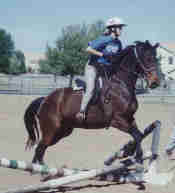
THE HORSES DREAMS ARE MADE OF:
THE SPECIAL HORSES USED IN THERAPEUTIC RIDING PROGRAMS
by Susan "Sam" Madden

Many people think of mounts for the disabled as quiet animals - so quiet you can't hear them breathe! The false notion is that these horses are all nicknamed "Elmer" and will spend the rest of their days giving pony rides at places like Camelot Therapeutic Horsemanship in Scottsdale, Arizona.
Camelot offers horsemanship as a means of therapy that improves strength, balance, coordination, and self-esteem by allowing those with physical challenges to realize goals they never before dreamed possible. More than a riding program, Camelot uses horses to foster quality life and equal participation for persons with disabilities.
The horses that these dreams are made of are hand-picked for their patience, intelligence, and adaptability. They must possess good manners both on the ground and under saddle and understand the word "whoa." Horses being considered for the Camelot program are often tested by having crutches knocked against their legs or by having someone crawl underneath them.
While horses must display tolerance, which often comes with age, they must also be healthy and sound. It wouldn't do to have a horse with navicular disease stumbling with a disabled rider! Therapeutic school horses lead active, productive lives; these programs are not retirement homes for infirm, unwanted animals.
Once accepted for a trial period, Camelot horses are turned out with a wheelchair to familiarize them with adaptive equipment. Eventually they learn to lean into the ramp as an equestrian in a wheelchair is mounting, to lower their heads for bridling by a disabled rider, or to be led and bathed by a blind person using a cane.
Camelot's string of champions includes horses of all sizes, backgrounds, and breeds. Each has special qualities that make him/her uniquely suited to working with the disabled.
Jake is a 23-year-old 15.2 hand Belgian-Quarter Horse cross who was previously on a dude ranch string and appeared in "B" westerns. He is so broad that students with little lower body strength find it easy to balance themselves on his "table" of a back. He is also oblivious to spastic leg movements (and sometimes even the most deliberate ones!), making him a safe mount for paraplegic riders.
Fast Lane is a 19-year-old 15.3 hand Tennessee Walker who was born into a therapeutic riding program, producing an especially sensitive and giving animal. Her running walk delights students on long trail rides where they can experience the beauty of the Arizona desert without cumbersome leg braces as an obstacle.
Scout is an 8-year-old 14.3 hand pinto who was a western pleasure horse before changing careers. He is small enough that students in wheelchairs can groom all of him - not just his lower half. One student, after using Scout to conquer her fear of cantering, was inspired to inquire about weight requirements for jockeys!
Acapulco Alibi is a 12-year-old 16.2 hand Thoroughbred-Quarter Horse who is an ex-"movie star," having played the part of a Pony Express steed in a trade show video. He had to gallop alongside a truck while being filmed out the window; stop dead while the rider tossed the reins, looping them over a hitching post; and stand perfectly still. Little did he know that being unfazed by commotion and respecting "whoa" were part of his training for a future with disabled riders. He was also a successful hunter who was retired from the show ring when his benevolent owner donated him to Camelot.
I am a former equestrian who has been totally blind for the last seven years, and working with this big, strong horse with a heart to match has challenged me and made me realize that my potential as a blind equestrian lies beyond jogging around in circles on a lunge line. This horse has given me much more than pony rides - we are now collecting nicely, doing flying lead changes, and jumping!
Most importantly, Acapulco has rekindled my spirit and unleashed my dreams, which now include training for my reentry into equitation and pleasure classes with the aid of a radio transmitter and a sideline coach to be my "eyes."
Reaching personal goals at Camelot empowers disabled students to be recognized for their talents and achievements, for the feats they have attained and the dragons they have slain, and not for their limitations. Camelot's special horses inspire the physically challenged to have the courage to set and achieve goals and to dare to dream of lassoing the moon!